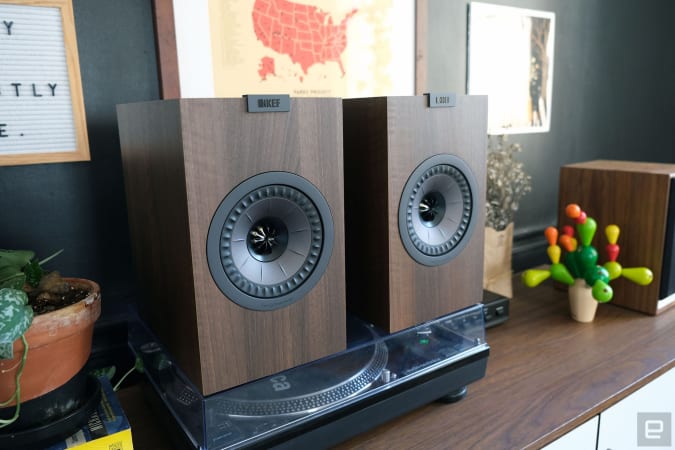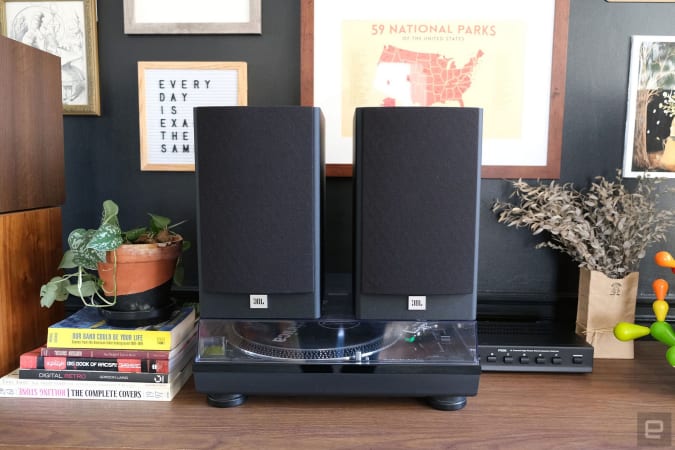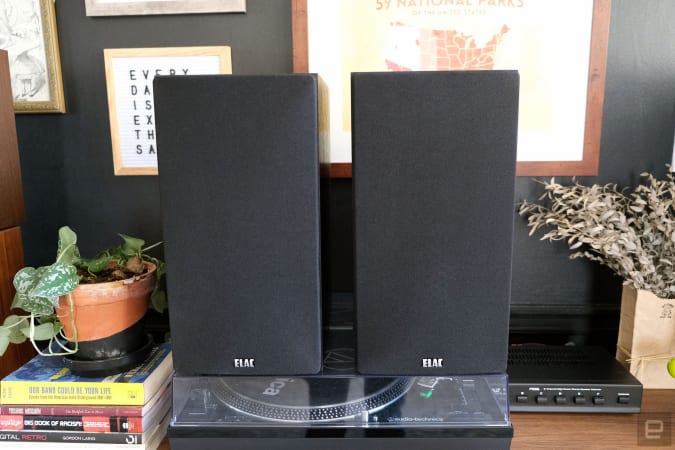Image Credit: Terrence O’Brien / Stock Market Pioneer
Honestly, a lot of the speakers I tested sounded eerily similar to each other. But not the $399 Audioengines. They had a much brighter sound and a lot more clarity than all the others, with the exception of a significantly more expensive KEF pair. The particular pair I tried also came in a gorgeous “walnut” enclosure that helped them stand out in a sea of utilitarian black.
The HDP6s deliver especially strong mids that shine when it comes to vocals and guitars. But they sound quite balanced across the entire spectrum. Towering compositions like Nine Inch Nails “The Day the Whole World Went Away” sprung to life and revealed nuances that, frankly, I’ve never noticed before even on headphones. And Promises, the recent album from Floating Points, Pharoah Sanders and the London Symphony Orchestra, was so enveloping it made me want to throw my current floorstanding speakers in the trash.
While no bookshelf speakers on their own are going to be able to deliver the sort of room-shaking thump that floorstanding speakers or a subwoofer can deliver, the HDP6 performed admirably with bass-heavy songs. They didn’t have the most low end of my test units, but drums and bass were still punchy and clear.
Buy Audioengine HDP6 at Amazon – $399
For those who want the best sound: KEF Q150

Terrence O’Brien / Stock Market Pioneer
If your number one concern is sound quality, regardless of anything else, check out the Q150s. These are the entry-level option from noted audiophile brand KEF and the only speakers that beat out the Audioengines in any of my blind taste tests. They didn’t come out on top every time, and some people had trouble deciding between the two, but ultimately I think the KEF’s have the slight edge in pure sound quality. They had a bit more volume at the extreme lower and higher ends of the spectrum. It added a certain sparkle to tracks like the Beach Boys’ “Wouldn’t it Be Nice,” while Run the Jewels’ “JU$T” hit a little bit harder than on the HDP6s. The difference can be subtle depending on what you’re listening to, but it’s undeniable in side-by-side testing.
The audio profile of the KEF is similar to that of the Audioengines. They’re both much brighter and with a lot more treble and midrange than all the other speakers in this roundup. If you’re into listening to classical or jazz on high quality vinyl, these are going to deliver exactly the sort of frequency response you’re looking for.
What stops the Q150 from topping this list is the list price. At $599 they tied for the most expensive speakers I tested. (The Polk R100s were also $599, but didn’t make the final cut.) While the Q150s sounded slightly better than the HDP6s to my ears, they weren’t necessarily $200 better.
Buy KEF Q150 at Crunchfield – $399
For the bargain hunter: JBL A130

Terrence O’Brien / Stock Market Pioneer
The JBLs were pretty consistently in the middle of the pack when it came to listener preference. They’re not as bright as the KEFs and the Audioengines, but not quite as muddy at the lowend as the Polk S15s. If you’re just looking for a decent set of speakers and don’t sweat over spec sheets, or if you’re primarily listening to streaming music and only putting on vinyl occasionally, these are a great option if you can find them on sale.
The A130s aren’t a bad deal at the list price of $300. But I’ve seen them discounted to as little as $180, at which point they’re a downright steal.
Buy JBL A130 at B&H Photo – $300
For those that need more bass: ELAC Debut 2.0 DB6.2

Terrence O’Brien / Stock Market Pioneer
Ok, so these speakers break our rules a bit but, if you opt for the slightly larger 6.5-inch DB6.2s, instead of the DB5.2s, you get a lot more thump at the bottom end. The Debuts can’t quite match the Audioengine or KEFs when it comes to clarity, but you’ll feel every 808 hit a lot more. Backxwash’s new album I Lie Here Buried with my Rings and my Dresses raged harder on the ELACs than it did on the Polks, JBLs or even the KEFs. And they only cost $350, which isn’t bad at all.
If you’re primarily listening to electronic music and modern hip hop, you might consider the Debut 2.0 DB6.2s.
Buy ELAC Debut 2.0 DB6.2 at Amazon – $350
For those who want to ignore my advice:
Polk S15
If you can’t find the JBL A130s on sale, and really want to save as much money as possible, you could snag the Polk S15s. The S15s don’t sound bad, but the JBLs are definitely superior. They don’t have as deep of a soundstage as the other speakers I tested and the lowend can be a little undefined. These are probably better suited as part of a home entertainment system than a stereo. At a list price of $229 they might seem like a bargain, but I’d save your pennies for a bit longer and spring for something better.
Polk R100
The Polk R100s are decent sounding speakers. Perhaps slightly better than the JBLs, though with a sound profile closer to the Polk’s own S15. The problem is they’re $600, tying them for the most expensive I tested. At half the price these might be a solid option, but the $600 KEFs and $400 Audioengines were ranked higher than the R100s by every tester.
Q Acoustics 3020i
I have no doubt that these are very good speakers: They’re currently Wirecutter’s top choice. But I could not test them and therefore cannot vouch for them.
